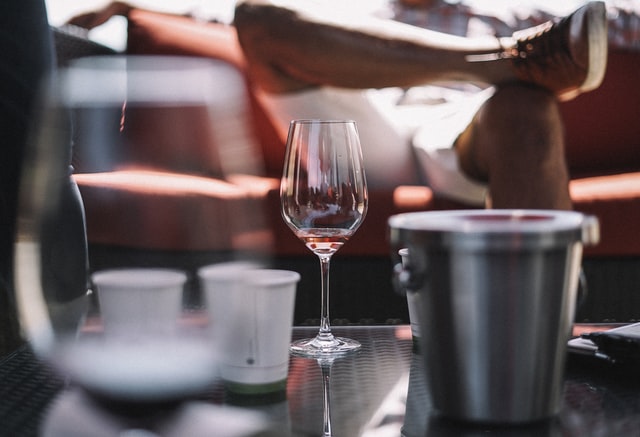As Keats so wonderfully wrote, Autumn is a ‘season of mists and mellow fruitfulness,’ when the trees are laden with ripe fruit just ready for picking and the hedgerows sweetly scented with an abundance of plump juicy berries. And what better way to use up a glut of apples or a barrel-load of blackberries than to make fruit wine? Making your own fruit wine isn’t complicated nor does it require loads of expensive equipment; what you do need though is patience.

Jump To...
Equipment to Make Fruit Wine
You can buy specialist items online or in any large store that has a home-winemaking section.
To make 6 bottles of fruit wine you’ll need
- 10 litre plastic bucket with a well-fitting lid
- 5 litre demi-john (a wide-bodied glass or plastic bottle with a narrow neck)
- air lock
- siphon (plastic pipe) and U-tube
- straining bag (alternatively use a large piece of muslin or a large fine sieve)
- funnel
- thermometer
- sterilising tablets
- hydrometer (optional) – helps determine when fermentation has finished
Fruit Wine Ingredients
- fruit
- sugar
- water
- pectic enzyme – a natural enzyme that breaks down the cell walls of the fruit, allowing the juice to escape
- yeast – converts the sugar into alcohol. Special wine-making yeast should be used in preference to the bread-making variety
- yeast nutrient – helps the yeast to do its job properly
- citric acid – to add zingy sharpness to your wine
- campden tablets – to kill some bacteria and also inhibit the growth of wild yeast, which can affect the finished wine
- finings – to clear the wine
How to Make Fruit Wine
First wash the bucket and its lid in warm water and sterilise according to the instructions on the packet.
Prepare the fruit by first washing in warm water. Remove the stems and any rotten or damaged bits but don’t peel.
- Hard fruits: slice into the bucket
- Soft fruits: place in bucket and mash slightly.
- Remove stones from large fruit but small pips and stones can remain.
- Add 1 litre of boiling water and 400g sugar and stir well.
- When the sugar has dissolved add cold water so the liquid just covers the fruit.
- Leave until the temperature has dropped to 50°C and then add the pectic enzyme.
- Leave to stand for about an hour, stirring occasionally.
- Now, if necessary, add more cold water to bring the level up to the 3.5 litre mark on the bucket.
- Check the temperature and when it has dropped below 30°C, add the yeast.
- Stir well and leave for another hour before stirring in the yeast nutrient. (For quantities, see the instructions on the packets.)
- Now you need to leave the bucket, with the lid on loosely, for 3 days to ferment. It needs to be kept at a temperature between 20 and 27°C.
- Strain the contents of the bucket through the straining bag, sieve or muslin, through a funnel into the sterilised demi-john.
- Gently squeeze the fruit to extract the juices but don’t squeeze it to the bitter end – as bitter is what it will be!
- Dissolve the rest of the sugar in 800ml hot water and allow it to cool slightly.
- When its temperature is less than 40°C, add to the demi-john. The level in the demi-john should be 4.5 litres; if necessary add a little more cold water.
- Put the air lock in place and leave the demi-john at a temperature between 20-27°C for 3 weeks.
- When fermentation is complete add the campden tablets and stir regularly for the next 48 hours. Then add the finings as directed on the packet.
- The next stage is bottling but before that you may like to do a preliminary taste test. The true flavour of the wine won’t emerge until it has been allowed to mature but at this stage an early indication of the way it will develop can be seen and corrected if necessary.
- If the wine isn’t sweet enough, add extra sugar or grape juice concentrate.
- After adjusting the sweetness, check for acidity. If the wine lacks a zing, add some citric acid.
When you are happy with the taste, siphon carefully into sterilised bottles, making sure you leave all the sludge undisturbed at the bottom of the demi-john. Cork and leave to develop for 4 weeks or longer.
Fruit Sugar Ratios – A Winemaking Guide
For 6 bottles of wine you need:
- 2kg apples to 1.3 kg white granulated sugar.
- 1.2kg blackberries to 1.3 kg white granulated sugar.

Are there any other fruits you can use to make Home made wines?,I’m thinking of starting to make My own wine,for a hobby also for my family barbeques Thank you max